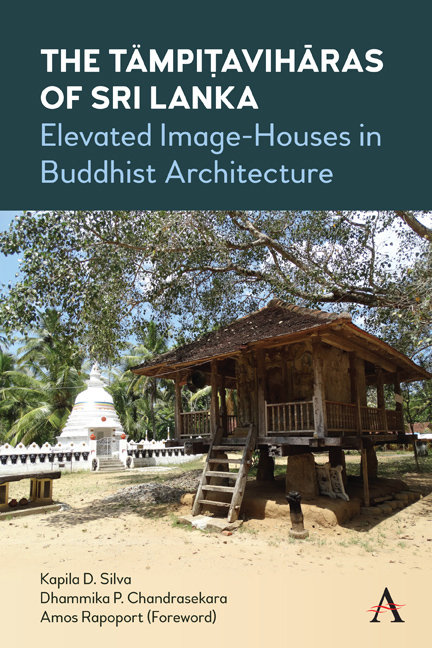Southern Province
Published online by Cambridge University Press: 16 December 2021
Summary
Hatāgala Ṭӓmpiṭavihāra, Hambantoṭa District
This ṭämpiṭavihāra is located ½ km off from Hatāgala junction on Tangalla-Hambantoṭa road. The temple premises were given to Vagēgoḍa Indasāra Thērō by Kīrti Śrī Rājasiṅghe and the ṭämpiṭavihāra was constructed later in 1795 during the reign of Rājādhirājasiṅghe (1780– 1798) (Abeyawardana 2001). The square-shaped image-chamber is raised just two feet above the ground by eight short pillars and the ambulatory is placed on the ground level. There is no additional maṇḍapa in the front of the structure. Because of this very low-rise and compact arrangement, the ṭämpiṭavihāra looks almost like a plinth-type image-house. The shrine contains three Buddha images, one seated and two standing, and images of gods Vishnu and Skandha.
Māboṭuwana Ṭӓmpiṭavihāra, Gālle District
Located 4 km west of Waňduramba junction on Waňduramba-Imadūwa road in Baddēgama, the history of the temple and the ṭämpiṭavihāra dates to the Dambadeṇi period. It is believed to be built by Dēvapatirāja, a minister of Parākaramabāhu II (1236– 1270), in 1240. This is one of the most exquisitely ornamented ṭämpiṭavihāra in the country, especially its sanctum, which still retains its original architectural details. The walls of the cella are thicker than usual and are ornamented with mouldings at the four corners, base, and the ceiling, with an elaborated makara-toraṇa on the front entry and murals on both exterior and interior surfaces. The cella is also unusually tall and provides enough space to have a standing image of the Buddha as the main icon in addition to two more standing images on the sides, which is an exception to the ṭämpiṭavihāra tradition. If the history of the ṭämpiṭavihāra truly dates to the Dambadeṇi period, having a standing image as the main icon could be an influence carried over from the Polonnaruva period in which several paṭimāghara had standing Buddha colossi as the primary image. Images of gods Vishnu and Skanda are sculpted as standing images on the sides, and images of gods Saman and Ganeṣ are painted on the walls. The ṭämpiṭavihāra is constructed on a high plinth and stone boulders, making a grand appearance. A set of concrete beams and props has been built recently along the perimeter of the ambulatory for additional support.
- Type
- Chapter
- Information
- The Tämpitaviharas of Sri LankaElevated Image-Houses in Buddhist Architecture, pp. 151 - 160Publisher: Anthem PressPrint publication year: 2021

